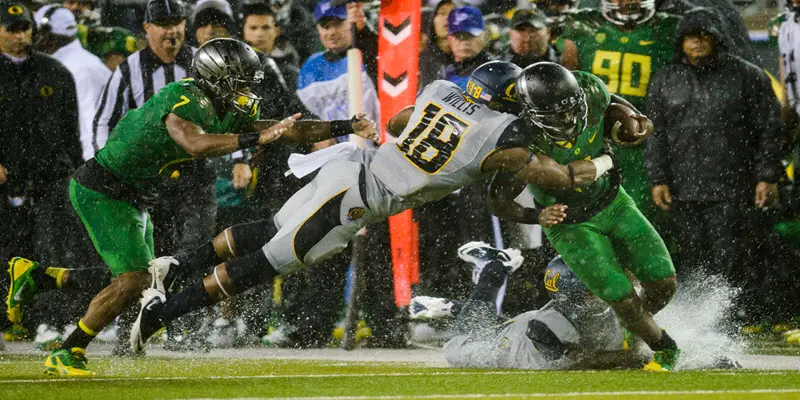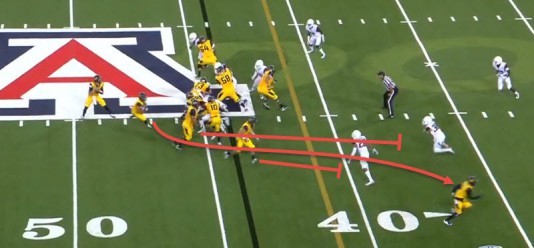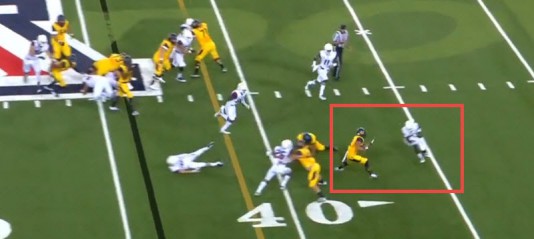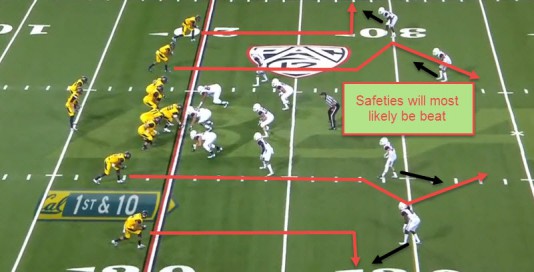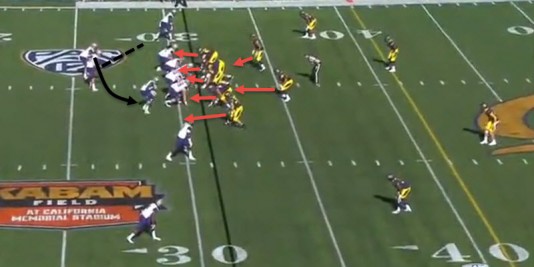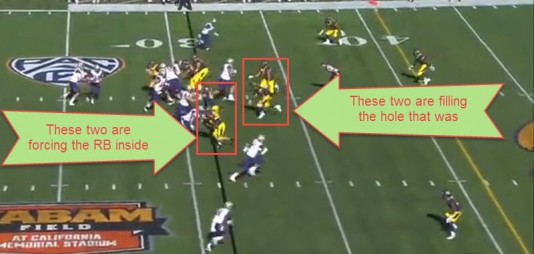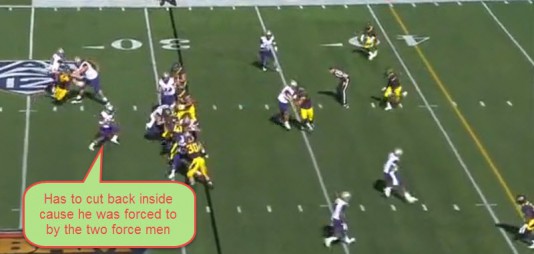That game back in late September — the one against Washington State — is one the Ducks remember. That was the first time this season when Oregon was exposed, offensively and defensively speaking. I bring this game up because Cal reminds me of Washington State on offense.
They pass the ball nearly as much as Washington State … look no further than the game between the two early this month, in which Jared Goff (Cal QB) and Connor Halliday (Washington State QB) combined for 86 completions on 123 pass attempts, 1261 passing yards with 11 touchdowns through the air, and ZERO interceptions. Cal runs similar formations and has similar weapons as Washington State. The difference between the two is that Cal has a much more potent running game.
After the Ducks’ close win over Washington State and Arizona’s Hail Mary win over Cal, I decided that between these two teams, there would be at least two upset victories.
To start, Goff, the Bears’ sophomore signal caller, is having one heck of a year. Last year, he became the first true freshman to start a season opener at quarterback for the Golden Bears, a school attended by Aaron Rodgers, Kyle Boller, Steve Bartkowski, and 10 other NFL quarterbacks.
He started off last year on fire, but he ended up being very inconsistent. This year is a different story; he’s averaging more than 350 yards and nearly four touchdowns per game. Sophomore quarterbacks don’t put numbers like that up unless they have names such as Johnny “Football” Manziel or Jameis “Crab Legs” Winston.
It helps to have weapons such as Bryce Treggs, Trevor Davis, Chris Harper and Darius Powe to exploit. If it wasn’t for the less-than-stellar reputation of the Bears, as of late, he would be on many Heisman watch lists.
To begin, take a look at the screenshot above. This is one of the first plays of the Arizona game, and it’s a big one.
This formation is somewhat similar to one of Stanford’s power formations, as the right side of the formation is completely overloaded with only two players left of the center. They are telegraphing where the ball is going to go — run right — but because of its blocking and pass threat, the defense doesn’t actually know where the ball is going.
Now, at the snap, the left guard, the tight end lined up in the wing and the fullback make the key blocks on the play. The left guard pulls, gets to the second level and blocks the strong safety, while the fullback kicks out the extra defensive back. Finally, a third block that is given by the tight end seals off the lane by a block to the right defensive end.
The hole created by the superb blocking of the Cal players makes Khalfani Muhammad’s job much easier. He just runs straight and sidesteps one defender. Wait … some of you may wonder what happened to the corner covering the Cal receiver wide right. Well, way down field, the receiver locks onto the Arizona corner and blocks him for 20-25 yards, something coaches love to see.

Good blocking for the Bears.
The result of the play, as you can see in the GIF above, is a 44-yard touchdown run and a quick start to the high-scoring Arizona vs. Cal game.
This next play is the very first play on Cal’s subsequent drive. As you can see, Cal lines up in doubles (two receivers on either side) and Arizona’s defensive backs play zone. The two inside receivers run what I call “corner-post” routes, while the outside receivers run eight-yard-out routes.
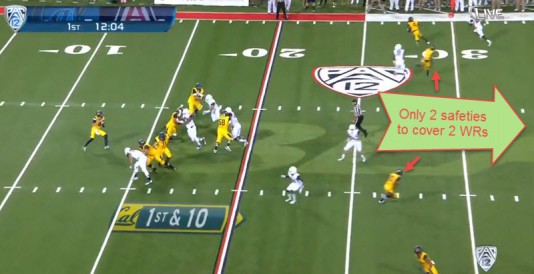
The two safeties are left alone to cover two receivers, both running double moves … nearly impossible.
This concept of outside receivers running shorter routes and inside receivers running deeper routes is a common one. This is just one of the ways Cal employs it.
The routes run by the outside receivers each draw the attention of one of the linebackers and a defensive back, leaving the speedy inside receivers one-on-one with the safeties, a match-up clearly in favor of the offense.
The rest is up to the receivers. Each of them runs a double-move route, where they break outside like they’re running a corner route, but then plant the outside foot and turn back inside to run a post route. Depending on how good the safety is, how good the fake by the receiver is, and how much help the safety has, this route often results in the safety biting on the fake and giving the receiver more than a step advantage.

During this season and 2013, Cal’s defense has been anything but stout, although this year’s edition is much improved from last year. Unfortunately for Cal, the team’s top tackler, safety Griffin Piatt, went down for the season against Washington with a knee injury.
This was, and still is, a major setback for the Cal defense, but because of its high-powered offense, often the defense just needs to make a stop or two and leave the rest to the offense. So, having said that, let’s take a look at how Cal will try to make one of those stops. (Below)
Above is a play from the Washington game. As you can see, Cal is using a 4-3 over defense. The “over” part of the defense is the important part. The outside linebacker on the strong side is on the line of scrimmage, in order to move quickly upfield and force the running back inside.
This concept is called “force and fill” — a common term used to tell players what to do on stretch plays, or plays that the offense hopes gets to the outside. The goal is that the defender, in this case the outside linebacker (above), will force the ball carrier back toward the middle of the field. Then a safety or linebacker will step, or fill, into the hole that the running back thinks he has and make the tackle.
As you can see, the Cal defense executes perfectly in this instance. The result is a rush for no gain as seen in the GIF below.

Last year, Cal (1-11) was a joke, arguably the worst Power 5 team. This year, that is clearly not the case. Cal has a Heisman-worthy quarterback with a plethora of receiving weapons. Ifo Expre-Olomu and the rest of the Ducks’ secondary will have to have to step it up in order to come away with a win tomorrow, or else Marcus Mariota will need to have a career day. But taking all of this in, the Cal team isn’t quite at the level it needs to be to beat Oregon, and the Ducks’ offense is kicking into gear and looking scary, so there’s a good chance it will be an Oregon rout, 59-31.
“Oh, how we love to learn about our opponents on FishDuck.com.”
Rory Davidson
Opponent Football Analyst for CFFNetwork/FishDuck.com
Eugene, Oregon
Top photo by Michael Arellano
Related Articles:
Chip Kelly Update: Everything's Good Again ...
Chip Kelly Update: Wailing and Gnashing of Teeth
Shock and Awe -- The Oregon Ducks' Football Hangover Effect
Despite Lopsided Score, Georgia State "Never Stopped Believing"
Hope Springs Eternal for Ducks
Incompetent Pac-12 Officials: How Do You Miss ALL of THIS?
Rory Davidson: Rory (Football Analyst) is a sophomore at Oregon in the fall (Class of 2018). He has been a devout Stanford football fan since he was 2 months old and is excited about the energy and greatness Oregon sports has to offer. For the past 6 years he has been doing advanced data analytics for his high school football team and working alongside the coaches to understand how they strategize about the game. He wants to integrate more statistics into his analyses and try to help readers learn about and understand the future of sports.

